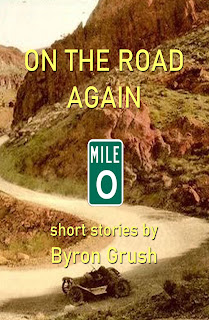Once Upon a Gold Rush
Once Upon a Gold Rush is an old-fashioned adventure story filled with colorful characters, framed against the California gold rush of the 1850s. Based on a (mostly) true story, it follows two brothers, James and John Grosh, and their sister, Mary Jane, on an overland journey by ox-drawn wagon, from the prairies of Illinois, across the plains and mountains of the wild, unsettled territories, to the Trinity River valley of Northern California. There they mine for gold and witness the beginning of the end of a way of life for the Native American inhabitants of the Golden State. John returns to Illinois by ship, sailing around Cape Horn, a voyage that he will not soon forget. Their lives are touched by people and events leading up to the American Civil War. This historical novel is the continuation of the saga of the Grosh family, begun in the book, All the Way by Water.
The author, Byron Grush, had recently completed All The Way By Water but realized that there was more to his ancestors’ story. There was an indication that John Grush, his great grandfather, had gone to California during the era of the 1849 gold rush. His brother, James, had apparently gone along and then disappeared. Digging deeply through a wealth of documentation, including diaries and letters written by the forty-niners and their families, Grush discovered a journal which mentioned the brothers. The journal, kept by Solomon Kingery, a resident of the same township where the Grushes lived, detailed the overland route from Illinois to California taken by the pioneers. This journal became the outline for the first section of Once Upon a Gold Rush.
The book is fiction, of course, as nothing is known about the actual events experienced by Grush’s ancestors. The author interweaves his story with historical facts and introduces the reader to many of the intriguing personalities of that time and place. Just as All The Way By Water touches on the theme of slavery in antebellum America, Once Upon a Gold Rush concerns the conflicts between the influx of white “Americans” to California and the Native peoples who lived there. John returns to Illinois nine years later. He travels by clipper ship, sailing around Cape Horn to Rio and then through the Caribbean to New Orleans. Again the realities of slavery and injustice affect him deeply and prompt him to take action.
Will there be a third book in the Grosh Saga? It is a distinct possibility, says Grush. “There are a few of the fictional characters in the story that might go on to have adventures.” The second book ends just as events leading up to the American Civil War come to a head. After that bloody conflict ended, the ethnic cleansing of Native Americans intensified and the hatred and reprisals against Freedmen of color opened a wound that refused to heal. “This is all part of our heritage,” says Grush. “It’s an ugly history that continues to influence our lives today. There is a threadbare old cliché which says that the only thing we learn from history is that we learn nothing from history.”




Comments
Post a Comment